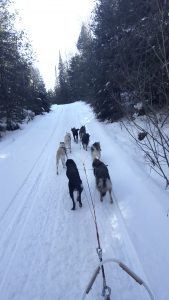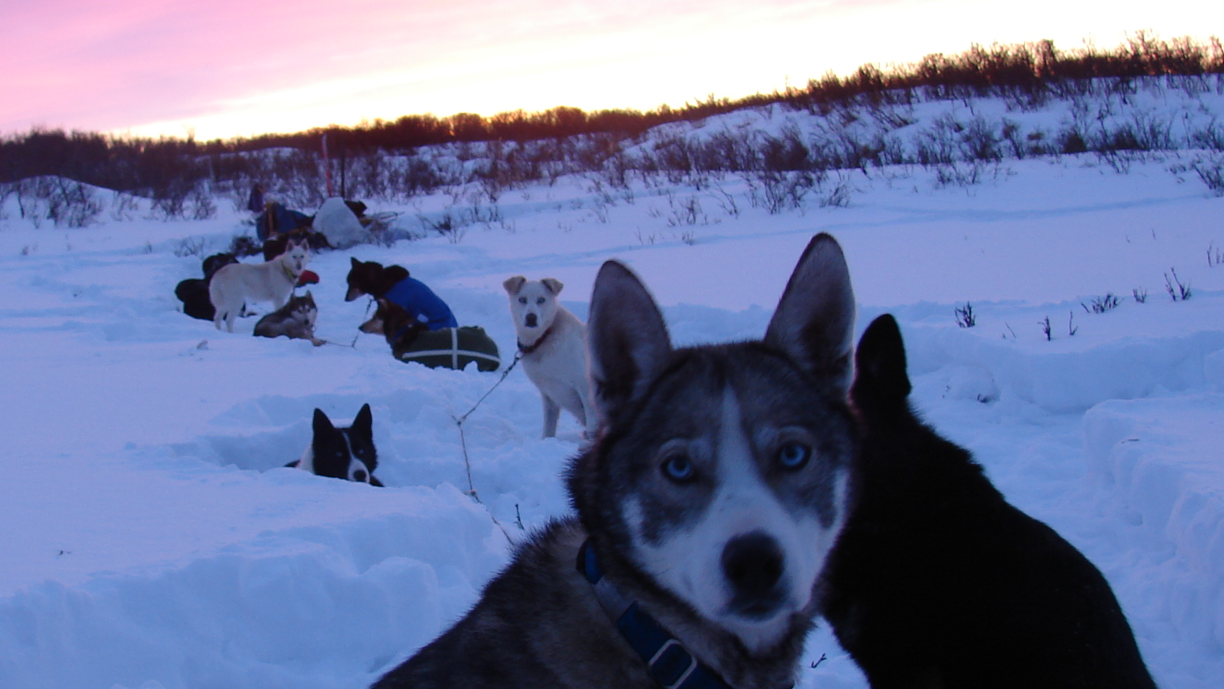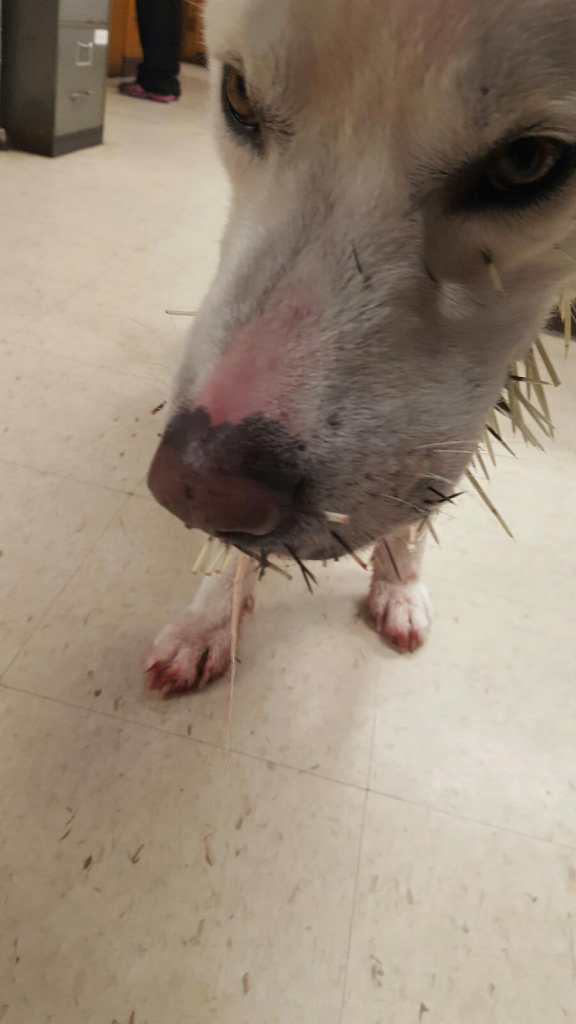
Dog teams consist of living creatures, and they can sometimes behave unpredictably during on-trail encounters. The experience level of the dogs and the musher cannot be gauged when you first see them on the trail, so the safest approach is to slow down, and yield to the team. Here are a few specific thoughts for different passing scenarios:
Snowmachines (snowmobiles) or ATVs: Head-on passing. Pull off to the side of the trail, turn off your machine, and turn off your headlight if there is time. If you have a sudden encounter and there is no time to stop, slow down as much as possible. Generally, dog teams will pass to the right (just like cars in North America), but you should not count on this. Inexperienced or startled leaders might jump to the left, in front of your sled, or even split two leaders to either side. The safest thing to do is pull over and stop, so that you are a stationary object for the dogs to go around.
Snowmachines (snowmobiles) or ATVs: Passing from behind. The alert musher will guide you on whether to pass or wait. If the musher has time and trail conditions are suitable, he or she will stop the team, plant the snow hook, and run to the start of the team to hold the front dogs off to the side (some very experienced teams might not need all of this, but most teams will still stop, or slow way down).
The musher will then wave or gesture for you to pass. Pass no quicker than a fast walking pace, in case dogs lunge into the trail and in front of you.
If the trail is wide enough that the musher waves you to pass while he or she keeps going, don’t rocket past. This is risky if the dogs suddenly move into your way, and might startle the team. Instead, pass no quicker than a fast walking pace (i.e., 5-10 kmph) faster than the sled.
Cross-country Skiers: Head-on passing. Same as snowmobiles: If there is time, get off to the side of the trail, turn off your headlamp if you have one, and let the team pass. If the team runs towards you (perhaps they think you are bringing their dinner), you might need to guide them back onto the trail.
Cross-country skiers: Passing from behind. Are you sure you’re going that quickly? Passed teams will often speed up when there is someone in front of them, so only pass if you think you will stay ahead. Similarly to a snowmachine, it’s best to communicate with the musher. You can yell out, “trail” or “passing left.” If trail conditions allow, the musher might wave you on. Or, the musher might ask you to stop so he or she can secure the team (as with the snowmachine scenario above). Go ahead and pass, being mindful of lunging dogs that might tangle your ski poles in their lines.
Dog teams: Head-on passing. Stay to the right (“gee trail”) and slow down. If the trail is narrow, you might need to lean your sled, or even lift it into the side of the trail. In a race, you should yield to the faster team or the team that is in the lead – in other words, the “behind” team should get furthest out of the way. Generally, it’s smartest to keep both teams moving quickly, so that the dogs have minimal time to interact. Even well-behaved dogs can act unpredictably when surprised by a strange dog that is suddenly sharing space with them.
In the event of a tangle between the teams, both mushers need to act quickly to prevent dog fights, or dogs getting strangled or caught in all the lines. Set your snow hook, then move the tangled dogs as quickly as possible out of the tangle. If only one musher’s dogs are tangled, and the other team was faster (especially in a race), it’s not impolite for the faster musher with no tangled dogs to depart immediately when the dogs are untangled. Getting the teams away from each other is the priority, lest you end up with a worse problem of more tangles, fights, or even inter-team mating (yes, this has definitely happened in races we have been part of! You’d be amazed how quickly the males can move, and once mated the dogs stay locked together for a half hour or so.)
Dog teams: Passing from behind. As mentioned with skiers, be sure you are likely to stay ahead. Often the “chase team” speeds up when there is a team ahead, but will the team stay that fast? What about the lead team suddenly becoming the chase team? If the teams are moving at similar paces, it might be best to stay in position, or have the trailing team stop for a few minutes. If the lead team is definitely moving slower, call for a pass.
If the lead musher didn’t already see the passing musher, the passer can yell “Trail!”, or if this doesn’t work can even move the team up so the lead dogs are next to the lead musher. The lead musher should stop, pull far off to the right of the trail if possible (even lifting the sled into the soft snow off the side of the trail). Set the snow hook, and run to the front of the team to hold the dogs off to the side. The passing team can then go by, as quickly as possible, to avoid tangles and team interaction.
Only on wide trails, or in truly competitive racing, should a team pass another moving team. Even if conditions are ideal for this, let the lead musher guide the pass – he or she might prefer to stop, perhaps because of dogs that get nervous or lunge at passing teams. Patience is key, because a poor pass with tangled teams, dog fights, or other mishaps are best avoided, lest the whole rest of the mush is ruined.
If you encounter a driver-less dog team. If you find a team without a musher, try to recapture the team if you feel able. Jump on the sled’s runners (the ski-like rails at the back of the sled), hold onto the handlebar. Then, look for the snow hook(s), and the brake or drag pad. Calmly call out “woah,” while stepping on the brake or drag pad. Drop the snow hooks, and stomp them into the snow to stop the team.
To slow down, you can also drag your feet, pull the sled into deeper snow, or even turn the sled so it’s dragging along its side.
Once the team is stopped and the sled is secure, see if there are lines on the sled to tie the sled to a tree or other structure, so the dogs don’t take off again. Tie the gang line near lead dogs to a tree or similar, if there is one, so the team doesn’t get tangled. Never tie off the team to a dog’s collar, since the team could strangle or injure the dog when pulling away.
Inspect the dogs for injuries. A lost team might run quickly, for miles, and dogs might be dragged or injured.
Look for musher contact info on dog tags, in the sled bag, or on the sled, and try to get in touch. If you are a musher, you could consider taking the team home with you. If not, securing the sled and the team might be enough, and then seek the musher. The musher is certainly aware his or her team is lost, and might be behind the team on the trail, trying to catch up.
General tips:
* Be visible. At night, put a flashing light on lead dogs. Use reflective lines, harnesses, or other gear.
* Don’t go faster than you can see ahead. This applies especially to snowmobilers during the daytime. If you cannot see around the corner ahead of you, will you have time for a safe pass if you encounter a slow-moving dog team in the middle of the trail?
* Yield to whoever has the least control for speed and location. Generally, this means that everyone should yield to dog teams (because they may suddenly move from one side of the trail to the other, and may be surprised by the noise or light of big machines). Skiers should generally yield to snowmobilers and dog teams, since they are usually moving fairly slowly with good ability to move to the side. Depending on conditions, such as very slick ground, steep downhill, etc. it might make sense to “give trail” (yield) regardless of your mode of transportation.


